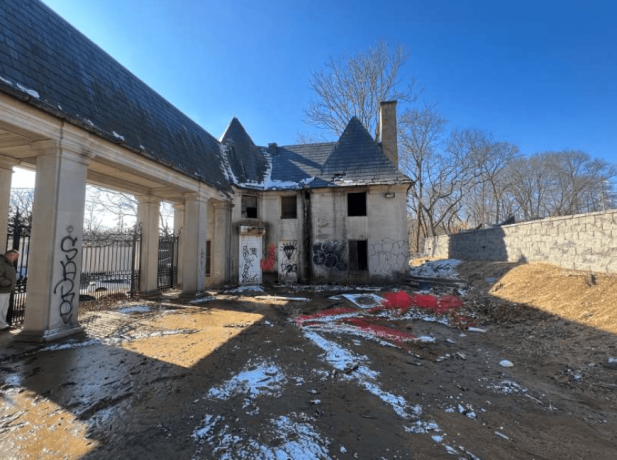The Roslyn Landmark Society is making progress on its restoration project for the Mackay Estate Gate Lodge, a historic relic of the gilded age in Roslyn.
The gate was the entrance to the 512-acre Harbor Hill Estate, built from 1900-1902 for Clarence Mackay. The estate was designed around 1899 by Stanford White’s firm of McKim, Mead & White. He was a prestigious architect in America in the late 19th and early 20th century who designed Madison Square Garden and the Marble Arch in Washington Square.
“This is one of the few remaining Stanford White buildings here on Long Island,” said Howard Kroplick, co-president of the Roslyn Landmark Society. “We’re kind of restoring a little piece of the gilded age to East Hills.”
The estate no longer stands after being demolished in 1947. The property is now the land that Country Estates in East Hills was built on along with multiple historical buildings that still stand from the original Mackay Estate.
Many historical events occurred at the Harbor Hill Estate, where aviator Charles Lindbergh ended his day after being honored at a Manhattan ticker tape parade in 1927 and passed through the very gate being restored, according to Kroplick.
Almost 50% of the village used to be the estate and Kroplick said it had a “tremendous effect” on the village of East Hill that it predated.
“The history of East Hills really begins with Harbor Hill and Clarence Mackay, so it’s really the beginning of the village,” he said. “This remaining gate lodge here is really a testament to the Mackay family and the importance they have to the village of East Hills.”
The landmark society’s goal is to restore the gate to what it originally looked like in the early 1900s and make it the East Hills History Resource Center.
Kroplick described the historical site as potentially becoming a “mini park” that people can visit for educational purposes and a location the village can host special events at.
The landmark society has an agreement with the village of East Hills, presenting a restoration plan to the village and soliciting suppliers to get the work done. Once they have the cost estimates, the landmark society will select the supplier and submit it to the village for approval.
Phase I of the restoration of the Mackay Estate Gate Lodge started in February 2022 when cleaning the site of the gate began. This phase also includes the stabilization of the slate roof, removal of the graffiti, cleaning the building’s limestone and the lodge’s surrounding walls, replacing the doors and windows and restoring the three gate components, which are from the original 1902 building.
Right now, the landmark society is reviewing bids for graffiti removal, one of the first steps at restoring the gate lodge. The gate is now covered in graffiti as it’s been “neglected” for the past 25 years, Kroplick said. Despite this, he said the gate is still in “beautiful shape.”
Kroplick said they are hoping to start graffiti removal as soon as the end of this month or early April. This is contingent on contracts being approved.
On Friday, Public Service Enterprise Group removed a dead tree leaning on the wires in front of the gate lodge.
The gate lodge restoration is being funded by grant money that the society seeks out, as well as funds from the existing property developer for the homes being built on the estate property and the Village of East Hills.
Kroplick said more money needs to be solicited in order to conduct the full project.
The cost estimate for the project is still being developed, but Kroplick projects that it will be at least $500,000.
He estimated that the restoration is about 2-4 years from completion.
“This is an exciting restoration project itself and we hope that the community will become more involved in it as we begin that phase I of the restoration,” Kroplick said. “We’re excited about it.”

